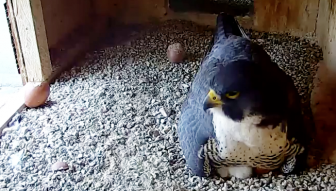
MANCHESTER, NH –Right now birding enthusiasts from around the world are watching the 13th floor of the Brady Sullivan Tower in Manchester. They are eagerly awaiting for two adult Peregrine Falcons to welcome baby falcons. This falcon couple is part of more than 20 known pairs of Peregrine Falcons living in New Hampshire.
Visible via a live, high-definition web cam with sound and night vision capabilities, Manchester’s Peregrine eggs began hatching on May 1 in the nest atop 1750 Elm Street. Students, birding enthusiasts and biologists from across the world watched – and heard – the entire process thanks to the new equipment donated by local telecommunications company Single Digits earlier this year.
“We were able to hear the soft chirps that the parents made as their eggs were hatching; the first sounds from the eggs as they start to hatch – that normally, a person would never hear,” said NH Audubon Senior Biologist Chris Martin. “Without a camera focused on incubating eggs, most NH Audubon volunteers hike to other nest sites, battle weather, swat black flies and more to collect the data that we can so easily obtain from the video feed in Manchester. Our Peregrine Falcon monitoring program reaches all corners of New Hampshire.”
In Manchester, the eggs have been incubating for the last five weeks, with the male and female falcon each taking turns keeping them warm. None of the other Peregrine Falcon nesting pairs in the state have cameras pointed on them, so Martin works with dozens of volunteers and the New Hampshire Fish and Game Department to monitor the more than 20 other pairs across New Hampshire.
And while the hatching itself is cause for celebration – most people have never had the experience of being a virtual foot away from hatching eggs. Once on the decline, the Peregrine Falcon was removed from the federal Threatened and Endangered Species List in 1999 and down listed from endangered to threatened on the New Hampshire list in September 2008. A collaborative effort lasting over three decades, involving the U.S. Fish and Wildlife Service, the U.S. Forest Service, NH Fish and Game, NH State Parks and NH Audubon, has led to the recovery of Peregrines in New Hampshire.
A major aspect of the recovery effort includes the organizations’ ID banding programs. Banding the birds gives biologists the ability to follow individual birds throughout their lives, providing important insight and data about the falcons’ migration and breeding patterns. Through the Federal Bird Banding Lab, which is a network of publicly-reported banded bird sightings, wildlife biologists communicate and interpret sightings and photographs submitted by professional birders and the public alike. All 43 Peregrine chicks fledged from the Manchester location have received small, lightweight identification bands to help biologists monitor the birds’ activity after they leave their nests.
This year will be no different, as NH Audubon, in partnership with NH Fish and Game and federally-permitted bird banding specialists, will attempt to outfit the chicks with leg identification bands on May 24. As the 2016 brood of baby falcons develops and grows stronger, they’ll spend the next six weeks or so waiting for food to be delivered by their parents before testing their wings and leaving the nest. The parents will keep track of the fledglings through vocalizations and continue to bring them food wherever they end up – baby birds are excellent at begging and yelling for food, Martin says. They may land in the parking lot below the nest, on a roof, or even back to the nest atop the tower. The chicks will continue to have food delivered by their parents for up to a month after they initially leave the nest and are strong enough to explore the nearby skies alone. They’ll then wander for most of the following year until next spring when they may find a new place to breed.
To learn more about the Peregrine Falcon Monitoring and Management Project and support the project, visit nhadubon.org. Watch the baby chicks stretch their wings in real time at bit.ly/nhafalconcam.







